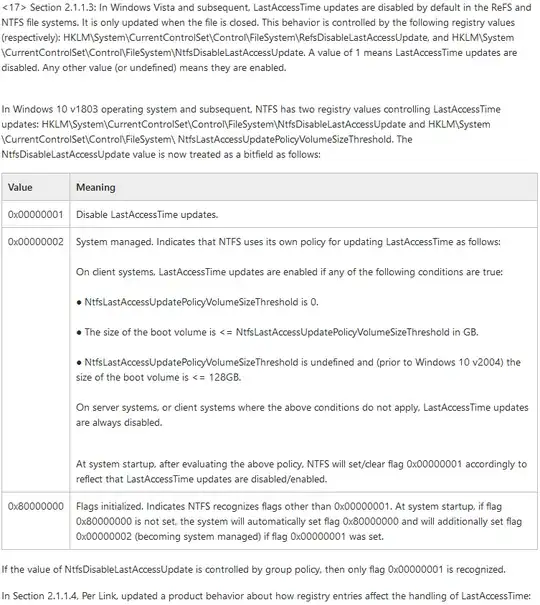My answer : No, there is no good reason to keep the Last Access Time
enabled.
Historical note
The Last Access Time has undergone many reverses.
There were times that it was enabled by default, and others that it was not.
There used to be a distinction between the states of "User managed" and
"System managed". In the later state, it used to be enabled only if the
system disk was less than 128 GB. However, since Windows 10 20H1 it's
always enabled by default, hence the poster's question.
How is it supposed to work
To reduce disk thrashing, the Last Access Time is kept in memory for
one hour before being flushed out to disk, in order to mimimize
disk I/O.
How does it really work
This was investigated by Msuhanov in the article
The (in)consistency of last access timestamps.
His results were not very encouraging :
- Disk write of the Last Access Time may happen after much longer time
than one hour. In one case, it was only written out after 12 hours
when Msuhanov gave up and turned off his computer.
During this period, a program might get either the old or new time,
depending on how/where it's getting it.
- Msuhanov also found out that there were two Last Access Times:
One in a file record and another one in an index record ($I30).
So, depending on the access API function, or the modify API function,
one would be dealing with one or the other, with no guarantee of
consistency.
What is it good for
Truly speaking, I can't think of anything.
Keeping track of which
files are being accessed is the only reason, but there are many reasons
for such accesses, for example antivirus scans, Windows Search Index
being updated and more.
The Last Access Time is not very useful in this regard, as no information
is kept of which program did the access.
All it says is that some program looked at the file, which doesn't help
much.
My conclusion
The Last Access Time is badly implemented and too unreliable to be really
useful, so you may go ahead and disable it.
I don't think that if enabled it will thrash the SSD, as SSDs are today
as robust (or more) as hard disks. The one-hour delay will ensure
that it will be written out at most once in any one hour, so this
will avoid thrashing. Disabling it might not be worth the trouble.
